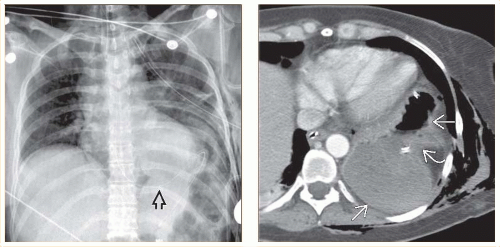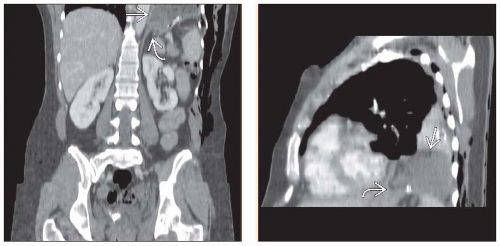Traumatic Diaphragmatic Rupture
Michael P. Federle, MD, FACR
Key Facts
Imaging
Due to blunt and penetrating trauma
Best imaging clue: Discontinuity of hemidiaphragm with “fallen” or “dependent” viscus sign
90-98% occur on left side
Herniated organs: Stomach > omentum, colon, small bowel, spleen, liver
Associated injuries are found in most cases
Plain film signs: Lower thoracic soft tissue density
Herniated fluid-filled hollow viscus or solid organ
Lower thoracic abnormal gas density
Herniation of hollow viscus
Loculated hydropneumothorax may also be present
Hard to distinguish from diaphragmatic rupture
CT signs: Discontinuity of hemidiaphragm
Intrathoracic herniation of abdominal contents
“Collar” sign: Waist-like constriction of stomach or colon at site of diaphragmatic tear
Abdominal contents lateral to diaphragm
“Fallen” or “dependent” viscus sign
Herniated viscus abuts posterior ribs, spine, thoracic wall
Helical CECT with multiplanar reformations: Best initial study
MR most accurate but not practical for unstable patient
“Dangling diaphragm” sign
Free edge of torn diaphragm curls inward
Top Differential Diagnoses
Eventration of diaphragm
Paralyzed diaphragm
Bochdalek hernia
Morgagni hernia
TERMINOLOGY
Synonyms
Traumatic diaphragmatic hernia
Definitions
Diaphragmatic rupture ± herniation of abdominal contents into thorax
IMAGING
General Features
Best diagnostic clue
Discontinuity of hemidiaphragm with “fallen” or “dependent” viscus sign
Location
90-98% occur on left side
Posterolateral part of diaphragm, medial to spleen
Size
Blunt trauma
Most tears are large (> 10 cm in length)
Penetrating trauma
Gun shot wounds (blast injuries) → large defects in diaphragm
Stab wounds → shorter lacerations
More likely to have delayed diagnosis
Initial short laceration may be overlooked; enlarges over time
Morphology
Curvilinear lacerations
Key concepts
Due to blunt and penetrating trauma
Occur in 1-5% of all blunt trauma victims
Accounts for 5% of all diaphragmatic hernias
Hiatal, Bochdalek, and Morgagni hernias are much more common
90% of all strangulated diaphragmatic hernias are due to trauma
Herniated organs: Stomach > omentum, colon, small bowel, spleen, liver
Stay updated, free articles. Join our Telegram channel

Full access? Get Clinical Tree












